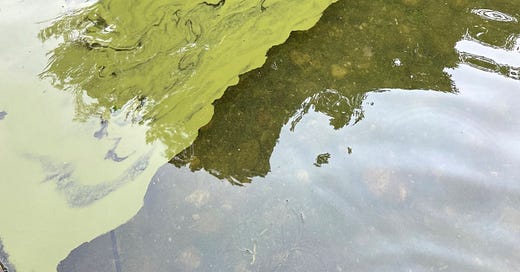Algae gone amok -- amuck -- and it's our fault
Millennia ago cyanobacteria ushered in life as we know it; now it's our freshwater Frankenstein
When the head of the Cape’s premier environmental watchdog group can’t swim in the pond by his home because periodic bacterial blooms are getting get worse, well, as Andy Gottlieb from the Association to Preserve Cape Cod says, “The irony is duly noted.”
Gottlieb and fam live on Wakeby in Mashpee, which joins Mashpee Pond to create the Cape’s biggest freshwater body, more than 700 acres, deep as 85 feet. You’d think ponds that big would be less prone to pollution and warmer temperatures creating “cyanobacteria blooms,” blue-green algae that coats the water, emitting toxins as well as foul odor with a disgusting look. But bigger ponds also invite more development, more septic systems and run-off:
“In 1961 there were 100 or so buildings around the pond,” says Gottlieb. “There are 477 now.”
As water heats up in the spring, the pond’s top and bottom layers mix. For five years cyanobacteria has moved up Wakeby’s water column, feeding on seeping human-made nutrients (phosphorus, nitrogen), exploding on the surface. A bloom lasted 26 days two years ago, a week to 10 days this spring. The bacteria dies down until late summer until cooling temperatures again mix surface and bottom, again encouraging algae slicks.
Two a year.
Because cyano can emit toxins that make people sick (though not all blooms will), especially dangerous for children and pets, the strong advice is to stay out.
“I hate it so much,” says Gottlieb. “Not being able to go down to the water, which is incredibly central to my well-being? It kills me. Dispiriting as hell.” He asked me to excise some profanity that laced these quotes, born of profound frustration, just for the sake of professionalism.
Gottlieb is far from alone. His organization tests 150 Cape Cod ponds a year, and “40 percent of them have water quality concerns”; APCC considers 60 percent to be “marginal.” Not all involve cyano (lesser amounts are natural everywhere), but from Santuit and Mashpee-Wakeby to Gull Pond in Brewster and Pilgrim Lake in Orleans, blooms are widespread.
“Every year is different,” says Gottlieb, “but the macro trend is up, and up, and it’s bad.”
Water treatment means dumping liquid alum into a pond, a heavy metal that binds with bacteria and keeps it from releasing up the water column. Alum can help for as long as 10 years, but no one likes the idea of yet more man-made product loading into freshwater.
Besides, alum is not a real solution, even short-term. As more runoff enters, alum already dumped can’t bind to new stuff; Pilgrim Lake shut down this spring even though it had been treated.
Best to think of alum as helping ponds take a breather, “not let them go belly-up,” as Gottlieb puts it: Buy time but commit to real solutions, stop wastewater running out of septic systems, slow nutrient loading from lawn fertilizers, hold back stormwater run-off.
We think of cyano as evil, but millenial history says otherwise. This bacteria (which created the oldest known fossils), was crucial in releasing oxygen in what’s called “the Great Oxidation Event” that allowed life as we know it to evolve. Before cyanobacteria, they say the sky was orange; blue is because of oxygen they created.
But that doesn’t make anyone feel better staring at stinking blue-green muck atop a pond they love.
I learned to swim in a mid-Cape kettle pond called Flax almost 60 years ago, and the only thing we wondered about far as water quality went was a little benign foam that gathered when the wind was pushing against the near shore. We joked it was frog spit.
Now I worry our status quo has changed so radically that people assume algae blooms, barren sand where eel grass once waved, No Swimming and No Shellfishing signs, is just the way it is. Accepting that makes the outrage and investment necessary to fix these problems harder to conjure.
Sorry to be cynical, but when degradations impact property values — inevitable, maybe already beginning — more money and focus on this incremental tragedy will, like an algae bloom, spread across our surface.
Haven’t subscribed yet? With all due respect, why not? Make it possible to see a Voice and support good reporting, strong perspectives, unique Cape Cod takes every week. All that for far less than a cup of coffee. Please subscribe:
https://sethrolbein.substack.com/welcome
And if you’re into Instagram, here’s some additional related material, another way to share the work:






Great article! The key is starting at the head of the watershed, not the coast at the bottom which is still a victim of the upstream flow. Ultimately distributed solutions with the best available technology must be utilized, as clearly this article and everyone who understands what's happening agrees, the crisis starts far from the coast.
Just finished watching the movie Dark Waters about the lawyer that sued DuPont for Teflon. People have also just accepted cancer causing chemicals in our water as a fact of life. The fight and the system is so overwhelming, most people have given up paying attention.